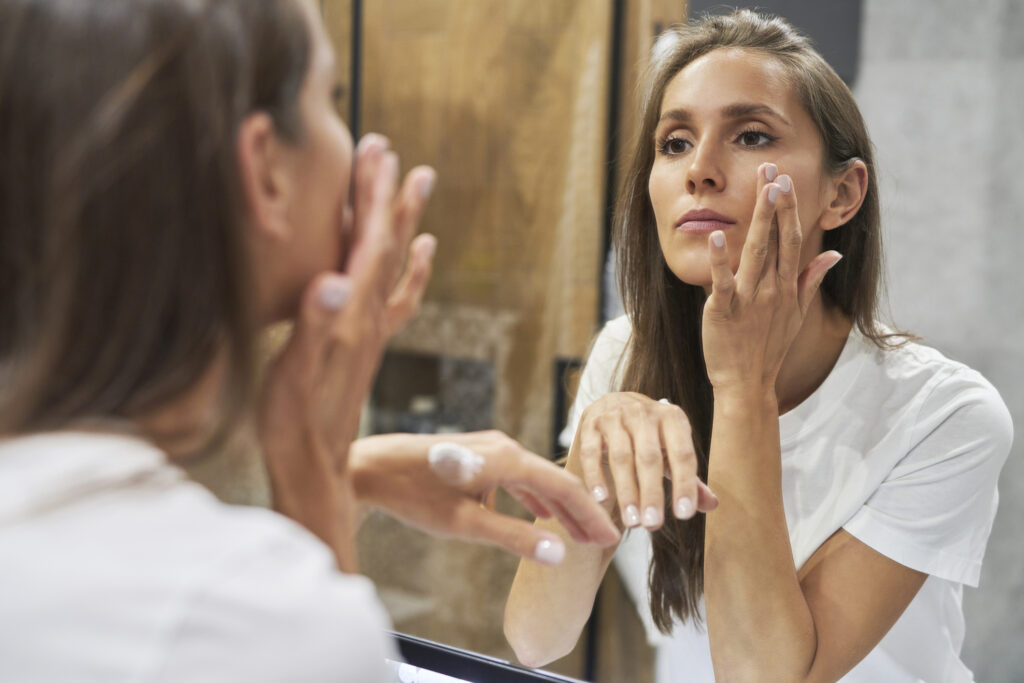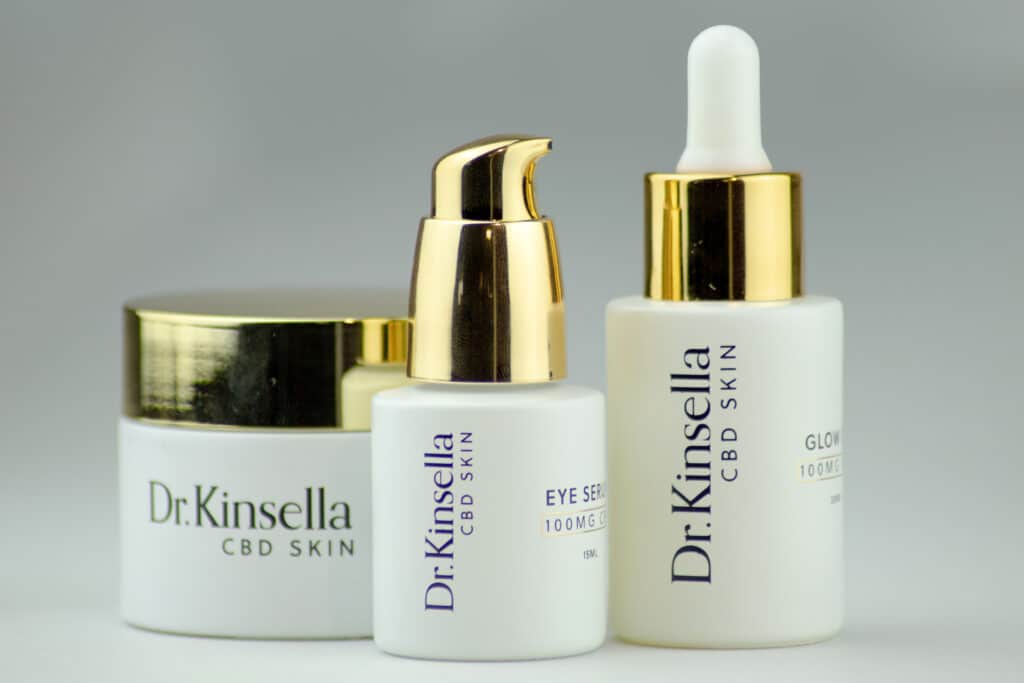GLOW OIL
FACE CREAM
EYE SERUM
Skincare Rules: How to Moisturise Your Face Correctly
Key points
- Moisturisers are an essential part of any skincare routine. They hydrate the skin, preventing and minimising dryness, slow down ageing, reduce acne, smooth out the skin, and prepare it for makeup application.
- When applying a moisturiser, you should first cleanse your skin and pat it with a towel. Then apply a moderate amount of cream directly to your face and spread it along the massage lines on your face using your fingers and going in gentle massaging motions.
- To increase the effectiveness of your face cream, try applying it to slightly damp skin, use a facial oil to seal it in, and make sure to apply your skincare products in the correct order, going from the lightest to the heaviest textures.
Moisturisers are the most popular skincare products. There is a simple reason for this: whenever we feel dryness on our skin, the first thing that comes to mind is to apply some face cream. Creams help to increase the amount of water in the skin, relieving dryness. Some moisturisers are also extremely effective anti-ageing agents.

However, as you walk through the shop and see shelves full of different brands of skincare, it is very easy to forget that the cream you select is not the only thing that matters, and you also need to know how to apply it properly. Correct application is one of the most important aspects of skincare because it determines whether all active ingredients in the product will work to make your skin more beautiful or simply sit on the surface with no effect. In this article, we will explain the proper ways to use moisturisers and tell you how to choose products that are the best at their job.
Why Do You Need to Use a Moisturiser?
The top layer of our skin is actually made up of dead skin cells. However, skin layers located beneath them serve as our skin’s water storage. Pollution, sun exposure, chemicals, and even our own immune system can all have an impact on how well those skin cells hold water. Insufficient hydration causes dryness and sensitivity, which can lead to loss of elasticity and premature ageing. That is why moisturisers are so important – they hydrate and hold water in and around cells, resulting in smoother and healthier skin.
The Benefits of Using Moisturisers
Prevent Dryness
The most apparent benefit is that creams help to combat dryness. Since cold and windy weather, air conditioning, or even heat can wick moisture away, moisturisers are essential for avoiding skin dehydration.
Slow Down Skin Ageing
Even creams that do not contain active ingredients for skin rejuvenation can help your skin look better because hydrated skin always looks younger. If you want to have plump and firm skin well into your 50s, start using moisturiser now to prevent future fine lines and wrinkles.
Reduce Acne
“It’s not clever to add more oil to already oily skin,” you might think. But the answer is simple: when our skin becomes dry, it naturally produces more oil, which clogs pores and causes acne. With hydrated skin, you will be able to balance the levels of sebum production, which will aid in the fight against all breakouts.
Soothe Sensitive Skin
Emollients can contain a variety of active ingredients, and if you have sensitive skin, look for ingredients that can soothe it. Jojoba oil, coconut oil, and vitamin C are a few examples.
Create a Base for Makeup
Moisturisers work well if you apply them before applying makeup. They help to smooth out the skin surface, making it easier to apply foundation or concealer. If you’ve had issues with foundation that looked cakey in the past, a good hydrating cream can help you avoid it in the future.
How to Use Moisturisers:
Сhoose Right Moisturiser for Your Skin Type
Because not all moisturisers will work equally well for you, it is critical to understand your skin type and choose products based on your specific needs. Some moisturisers are suitable for all skin types, so choose such products if you are unsure about yours. One of the best options is Dr. Kinsella Premium Face Cream. Its key active ingredients, such as vitamin C, CBD, and hyaluronic acid, work together to reduce fine lines and even out the skin tone. It’s an incredibly effective lightweight yet intensely moisturising cream formulated with ingredients that target specific skin concerns.

Clean Your Face
It is a commonly known and obvious fact that applying moisturiser on dirty skin is an extremely bad idea. No matter where you are or what time it is, you should wash your face before applying cream to remove environmental dirt, makeup, and sweat. Only then can you be certain that the cream will be thoroughly absorbed by your skin and won’t clog your pores.
Apply the Product to Damp Skin
Moisturisers are more effective when applied to damp skin immediately after cleansing. That’s because damp skin is more receptive to the product and allows the cream to lock in the moisture. So, instead of completely drying your face with a towel, leave it slightly damp or spritz on some face mist before moisturising.
Use a Facial Oil With Moisturiser
If you have dryness or irritation on your face, using a facial oil in conjunction with a moisturiser is a good way to combat these symptoms. By doing so, you can also avoid wrinkles and fine lines and keep the sebum production of your skin in a healthy range. Facial oils or oil serums are also effective in protecting your skin from environmental damage, which can result in oxidative stress, one of the primary causes of skin ageing.
Premium Glow Oil by Dr. Kinsella is a good option because it contains several key ingredients that help nourish, soothe, and soften the skin. It’s a lightweight, fast-absorbing oil rich in antioxidants, natural oils and fatty acids from sativa and rosehip oils, as well as vitamins C and E, which fight the results of oxidative stress.
Do Not Overuse
Some people believe that applying four pumps of moisturiser instead of the recommended two increases the effect and benefits of using it. Unfortunately, this is not the case. Using more cream means rubbing it on your face for a longer period of time, which causes your oil glands to produce more sebum. As a result, you will get a shiny T-zone instead of healthy skin. Furthermore, overusing a product means that it will not be able to absorb into the skin properly and will only clog your pores, leaving no room for other products such as sunscreen or makeup to absorb afterwards. So the best idea is to read the manufacturer’s instructions and figure out how much product you need based on them.
Use Products in the Correct Order
There are no hard and fast rules about how and in what order you should use different skincare products, but there are some guidelines for getting the most out of them. The general rule is to use products starting from thin textures and following with thicker ones.
The reason for this is that thin products will not get absorbed well if you apply thick products first, and thus they will not have the full effect on your skin. However, if you also use some prescribed products (for acne, for example), you should follow the advice of your dermatologist. In general, there’s no need to be too strict with the order because everything applied to the skin becomes a cocktail on your face. The scheme will work as long as you use thick creams and oils in the end.
Keep the Balance
Of course, everyone has their own unique needs and therefore chooses their skincare routine accordingly, but in most cases, less is more. Think twice before purchasing a new product, as it may not only be ineffective but may also reduce the effect of the products you’re already using.
Create a Routine
This generally comes down to personal preferences but having a night skincare routine is essential. Even though our skin requires hydration throughout the day, it loses the most water at night. This is because our skin’s oil production levels are highest at midday, and they dramatically decrease while we sleep. That is why it is critical to moisturise the skin overnight in order to replenish the water loss.
How to Apply Moisturiser Step-by-Step
- Wash your hands before starting the procedure.
- Do not rub moisturiser into your palms because the product will absorb into your fingers but not your face. Instead, apply small amounts of product all over your face, or apply a little to the back of your hand and smooth it out with your ring finger. You can also gently massage your face while applying the cream.
- Apply the cream in a circular motion without pulling on the skin. Put the cream on the centre of your face first and work your way outward. Remember to massage the inner corners of your eyebrows.
- Take care when putting on products on the most delicate parts of your face. Because the skin around your eyes is easily damaged, pat the cream gently until it is absorbed. If your moisturiser is heavy, it is best to avoid this zone.
- Massage your T-zone from the bridge of your nose to the tip of your nostrils, then move slowly towards the temples.
- Apply cream to the upper part of the lips and work your way up to the cheeks.
- After applying cream to your lower lip, massage it down to your chin.
- Ensure that the cream has been thoroughly absorbed before applying makeup or sunscreen.
Final Thoughts
Using a moisturiser is one of the most important steps in your skincare routine because it not only hydrates and nourishes your skin but also creates a long-lasting effect that allows your skin to stay youthful longer. It is also an excellent way to protect your skin from environmental damage. Of course, the most important thing is to select a product that is specifically designed for your skin, and we recommend that you only purchase products when you are confident in their quality. Dr. Kinsella product line is formulated by a doctor using only premium quality ingredients and is proven to bring real results. Use our high-quality products to start your skincare journey with confidence!
FAQs
When should we apply moisturiser on our face?
The most important rule is to apply facial moisturiser only after cleansing your face. Put it on slightly damp skin in the mornings and before going to bed for the best results.
How long should you rub moisturiser on your face?
It is beneficial to apply face cream using gentle massaging movements, but do not overdo it, as this may cause your oil glands to produce more sebum. This procedure can be completed in 3 minutes.
Can I sleep with moisturiser on?
There’s nothing wrong with leaving your facial moisturiser on overnight. It is actually the best option for your skin! This is due to the fact that our skin’s oil production decreases while we sleep. As a result, it is critical to moisturise the skin overnight to replenish water loss.
